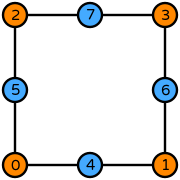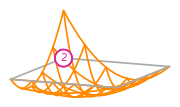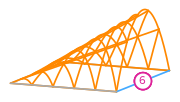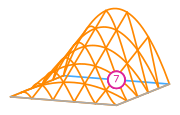an encyclopedia of finite element definitions
Degree 1 Tiniest tensor on a quadrilateral
◀ Back to Tiniest tensor definition page
- \(R\) is the reference quadrilateral. The following numbering of the subentities of the reference is used:
- \(\mathcal{V}\) is spanned by: \(1\), \(y\), \(x\), \(x y\), \(\frac{3 x \left(- x y + x + y - 1\right)}{2}\), \(\frac{3 x y \left(x - 1\right)}{2}\), \(\frac{3 y \left(- x y + x + y - 1\right)}{2}\), \(\frac{3 x y \left(y - 1\right)}{2}\)
- \(\mathcal{L}=\{l_0,...,l_{7}\}\)
- Functionals and basis functions:

\(\displaystyle l_{0}:v\mapsto v(0,0)\)
\(\displaystyle \phi_{0} = - 3 x^{2} y + 3 x^{2} - 3 x y^{2} + 7 x y - 4 x + 3 y^{2} - 4 y + 1\)
This DOF is associated with vertex 0 of the reference element.
\(\displaystyle \phi_{0} = - 3 x^{2} y + 3 x^{2} - 3 x y^{2} + 7 x y - 4 x + 3 y^{2} - 4 y + 1\)
This DOF is associated with vertex 0 of the reference element.
\(\displaystyle l_{1}:v\mapsto v(1,0)\)
\(\displaystyle \phi_{1} = x \left(- 3 x y + 3 x + 3 y^{2} - y - 2\right)\)
This DOF is associated with vertex 1 of the reference element.
\(\displaystyle \phi_{1} = x \left(- 3 x y + 3 x + 3 y^{2} - y - 2\right)\)
This DOF is associated with vertex 1 of the reference element.
\(\displaystyle l_{2}:v\mapsto v(0,1)\)
\(\displaystyle \phi_{2} = y \left(3 x^{2} - 3 x y - x + 3 y - 2\right)\)
This DOF is associated with vertex 2 of the reference element.
\(\displaystyle \phi_{2} = y \left(3 x^{2} - 3 x y - x + 3 y - 2\right)\)
This DOF is associated with vertex 2 of the reference element.
\(\displaystyle l_{3}:v\mapsto v(1,1)\)
\(\displaystyle \phi_{3} = x y \left(3 x + 3 y - 5\right)\)
This DOF is associated with vertex 3 of the reference element.
\(\displaystyle \phi_{3} = x y \left(3 x + 3 y - 5\right)\)
This DOF is associated with vertex 3 of the reference element.
\(\displaystyle l_{4}:\mathbf{v}\mapsto\displaystyle\int_{e_{0}}v\)
where \(e_{0}\) is the 0th edge.
\(\displaystyle \phi_{4} = 6 x \left(x y - x - y + 1\right)\)
This DOF is associated with edge 0 of the reference element.
where \(e_{0}\) is the 0th edge.
\(\displaystyle \phi_{4} = 6 x \left(x y - x - y + 1\right)\)
This DOF is associated with edge 0 of the reference element.
\(\displaystyle l_{5}:\mathbf{v}\mapsto\displaystyle\int_{e_{1}}v\)
where \(e_{1}\) is the 1st edge.
\(\displaystyle \phi_{5} = 6 y \left(x y - x - y + 1\right)\)
This DOF is associated with edge 1 of the reference element.
where \(e_{1}\) is the 1st edge.
\(\displaystyle \phi_{5} = 6 y \left(x y - x - y + 1\right)\)
This DOF is associated with edge 1 of the reference element.
\(\displaystyle l_{6}:\mathbf{v}\mapsto\displaystyle\int_{e_{2}}v\)
where \(e_{2}\) is the 2nd edge.
\(\displaystyle \phi_{6} = 6 x y \left(1 - y\right)\)
This DOF is associated with edge 2 of the reference element.
where \(e_{2}\) is the 2nd edge.
\(\displaystyle \phi_{6} = 6 x y \left(1 - y\right)\)
This DOF is associated with edge 2 of the reference element.







